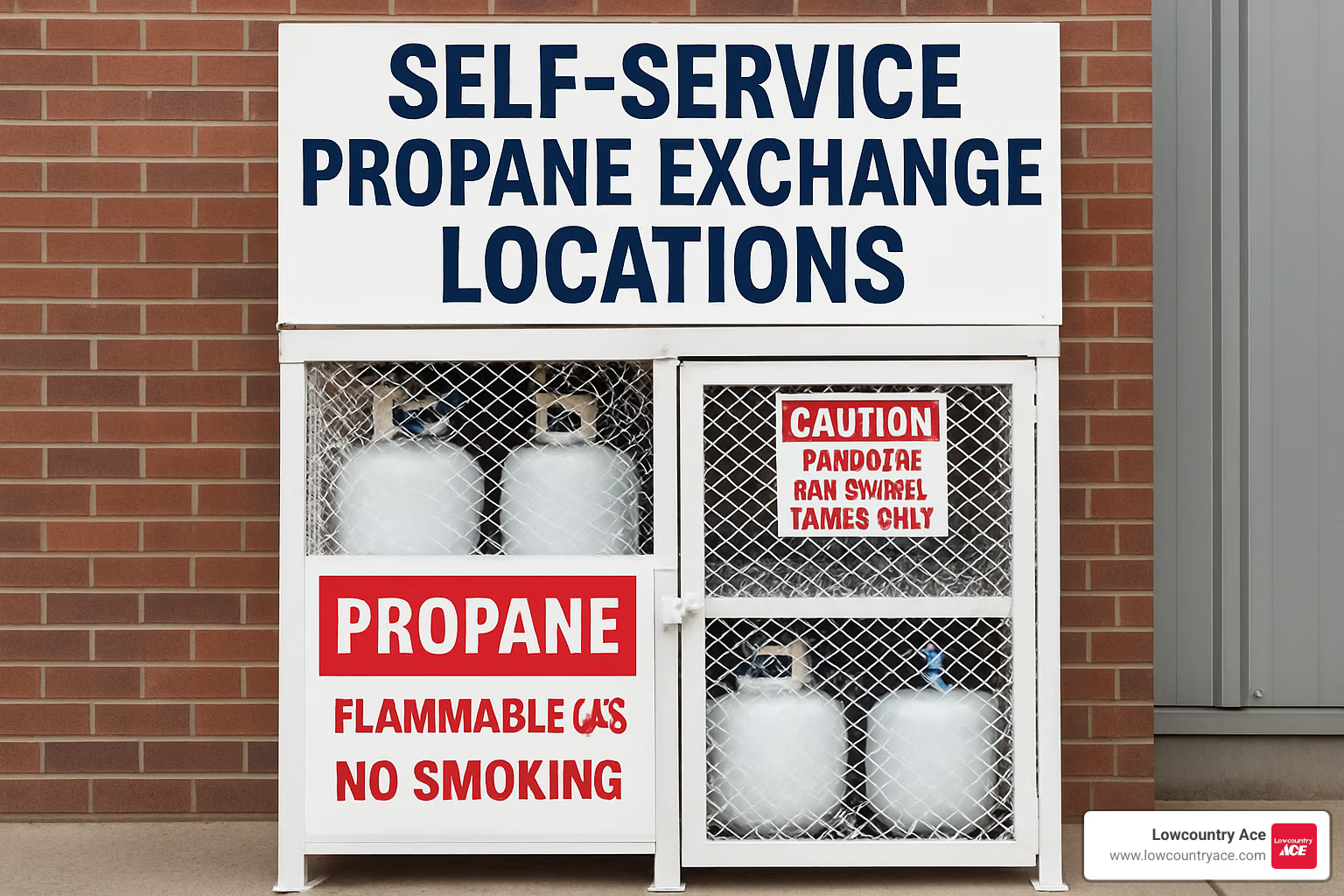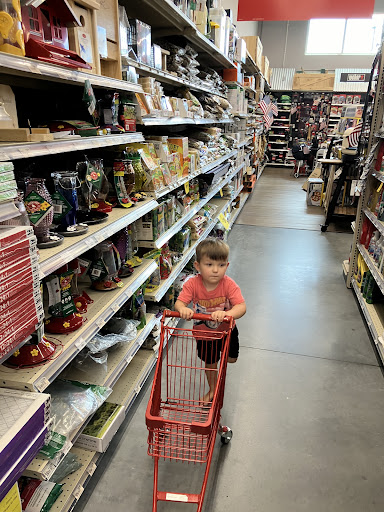Self Service Propane Exchange Locations: 7 Powerful Benefits 2025
Why Self-Service Propane Exchange Locations Are Revolutionizing Outdoor Cooking
Self service propane exchange locations have transformed how we fuel our grills, offering 24/7 convenience that traditional staffed exchanges simply can’t match. These automated kiosks let you swap an empty tank for a full one in under a minute, any time of day or night.
Quick Answer: Finding Self-Service Propane Exchange Locations
• Major retailers: Walmart, Home Depot, convenience stores, gas stations
• Search tools: Store locators, interactive maps, mobile apps
• Payment: Credit cards, debit cards, contactless payments, some accept cash
• Hours: Available 24/7 at most locations
• Coverage: Thousands of locations across North America
Gone are the days of waiting 10-15 minutes for a store clerk to open up a propane cage. Self-service kiosks work like ATMs – you follow simple on-screen prompts, pay with your card, and walk away with a certified, leak-tested cylinder. With extensive networks spanning thousands of locations across the United States and Canada, these unmanned stations are becoming the go-to solution for grill masters who refuse to let an empty tank ruin their cookout plans.
The revolution in propane access has been particularly beneficial for coastal communities like ours, where outdoor cooking is a year-round lifestyle. Whether you’re planning a sunrise fishing trip cookout, hosting an impromptu beach barbecue, or finding your tank is empty right before the big game, these automated systems ensure you’re never more than a few minutes away from getting back to grilling.
The helpful team at Lowcountry Ace understands the importance of convenient propane access for our coastal community’s outdoor cooking needs. Our experience with self service propane exchange locations helps us guide customers toward the fastest, safest options for keeping their grills fired up year-round.
Self service propane exchange locations terms you need:
Understanding Self-Service Propane Exchange Locations
Picture this: you’re hosting a weekend barbecue when your propane tank decides to call it quits. With self service propane exchange locations, you don’t have to wait until Monday morning or hunt down a store clerk with the cage keys. These clever unmanned kiosks work around the clock, dispensing certified cylinders faster than you can say “medium-rare.”
The helpful team at Lowcountry Ace has watched these automated systems revolutionize how our James Island and Folly Beach customers handle their grilling needs. No more missed cookouts because the hardware store closed early on Sunday.
These innovative systems represent a significant shift in how we think about propane access. Traditional propane services were built around business hours and staffed locations, but modern outdoor cooking doesn’t follow a 9-to-5 schedule. Weekend warriors, early morning anglers, and late-night grill masters all need reliable access to fuel, regardless of when inspiration strikes.
What is a self-service propane exchange location?
A self-service propane exchange location is basically an outdoor ATM for propane tanks. These weatherproof kiosks feature bright touch-screen displays that walk you through swapping your empty cylinder for a full one, no human interaction required.
The magic happens inside a secure outdoor cabinet that houses multiple certified propane tanks. When you complete your transaction, an automated door opens to reveal your fresh cylinder. The whole setup is designed to handle whatever Mother Nature throws at it, from Charleston’s summer humidity to those surprise winter cold snaps.
Most kiosks light up like Christmas trees at night, making them easy to spot in parking lots. The touch screens are large enough that even folks who struggle with smartphone apps find them straightforward to use. The interface typically features large buttons, clear instructions, and multiple language options to accommodate diverse communities.
The engineering behind these kiosks is quite sophisticated. They include climate control systems to protect the internal electronics, security features to prevent tampering, and inventory management systems that track tank levels and automatically alert service teams when restocking is needed. Many units also include backup power systems to ensure operation during brief power outages.
How does a self-service propane exchange work?
The beauty of these systems lies in their simplicity. Walk up, tap the screen to start your transaction, and follow the prompts – it’s that easy. The kiosk accepts digital payment methods including credit cards, debit cards, and contactless options like tapping your phone.
Once your payment goes through, the system tells you exactly where to place your empty tank. Some kiosks have you slide it into a slot, while others use a simple drop-off compartment. The machine then automatically dispenses a full, leak-tested cylinder from its inventory.
You’ll get a printed receipt showing your transaction details, and you’re done. The whole drop-swap-go process typically takes less time than finding a parking spot at the grocery store. No waiting, no small talk, just quick propane and you’re back to grilling.
The technology includes weight sensors that verify you’ve deposited an empty tank, barcode scanners that can identify tank types and conditions, and sophisticated dispensing mechanisms that ensure you receive a properly filled cylinder. Many systems also include cameras for security purposes and to help customer service representatives assist with any issues that might arise.
Self-service propane exchange locations vs. traditional exchanges
Traditional propane exchanges can feel like a trip back to the 1990s. You wait for someone to find the right keys, open up the cage, manually check your empty tank, and then walk you inside to pay at the register. During busy summer weekends, this dance can eat up 15 minutes or more of your precious grilling time.
Self-service kiosks flip this script entirely. No keys to find, no staff to track down, no lines to wait in. The automated systems handle leak testing and quality control behind the scenes, so every cylinder meets safety standards without the manual inspection routine.
The 24/7 availability is the real game-changer. Whether you’re prepping for a sunrise fishing trip cookout or realize at 11 PM that tomorrow’s tailgate needs fuel, these kiosks are ready when you are. Traditional exchanges leave you high and dry outside business hours.
From a business perspective, these kiosks also solve staffing challenges that many retailers face. Training employees on propane safety procedures, maintaining proper certifications, and ensuring consistent service quality across multiple shifts can be complex and costly. Automated systems eliminate these variables while providing superior customer experience.
| Feature | Traditional Exchange | Self-Service Kiosk |
|---|---|---|
| Average transaction time | 10-15 minutes | Under 1 minute |
| Availability | Store hours only | 24/7 |
| Staff involvement | Required | None |
| Wait times | Common during peak hours | Minimal |
| Payment options | Cash, card at register | Card, contactless at kiosk |
| Quality consistency | Variable by staff | Automated standards |
| Weather dependency | Indoor service | All-weather operation |
For retailers, these kiosks eliminate the hassle of training staff on propane procedures and free up employees to help customers with more complex needs. It’s a win-win that keeps everyone happy and well-fueled for their outdoor trips.
Finding Self-Service Propane Exchange Kiosks Near You
Finding self service propane exchange locations is easier than ever thanks to brand-run store locators, searchable maps, and GPS apps. Punch in your ZIP code on any major propane provider’s site and you’ll instantly see nearby kiosks, driving directions, and operating status—no scrolling through outdated text lists.
Interactive maps powered by latest map technology show every kiosk as an icon you can tap for distance, directions, and accepted payment methods. Most networks also offer:
ZIP-code text locators text your postal code and receive the three closest kiosks by SMS
Mobile apps with find propane now buttons that use your phones GPS
Real-time inventory indicators so you know full cylinders are waiting before you leave the driveway
In Charleston, results highlight grocery chains, home-improvement stores, and gas stations from Folly Beach up to downtown. For a local snapshot, check our guide: Propane Exchange Near Me.
Payment methods & hours at self-service propane exchange locations
Self-service kiosks have acceptd digital payments. Credit cards, debit cards, Apple Pay, Google Pay, and tap-to-pay cards work at virtually every unit; a shrinking number still accept cash. Because the system is completely automated, service is available 24/7—perfect for sunrise fishing trips or late-night tailgate prep. If the machine misbehaves, the on-screen 800-number connects you to live help in seconds.
Quality control & safety at kiosks
Convenience never overrides safety. Every cylinder in the network goes through a strict 12-step refurbishment that includes:
- External inspection and cleaning
- Valve and O-ring replacement if needed
- OPD (Overfill Protection Device) verification
- Pressure and leak testing
- Filling to 80 % for safe thermal expansion
Finished tanks receive inspection tags and are stored upright inside the kiosk until you arrive.
By combining around-the-clock access with bank-grade payment security and industrial-grade safety checks, self-service exchange kiosks make sure you spend your time grilling—not hunting for fuel.
Using a Self-Service Propane Exchange Safely & Affordably
Knowing the process ahead of time turns a first exchange into a 60-second errand.
Step-by-step: exchanging an empty tank
- Close the valve on your empty tank (hand-tight, clockwise).
- At the kiosk touch screen choose “Exchange,” insert or tap your payment card, and follow the prompts.
- Place your empty cylinder in the marked compartment; weight sensors confirm the drop.
- A door opens—remove your full, certified tank, grab the receipt, and you’re done.
Buying a new tank without an exchange
Need a spare for hurricane season or a beach-house backup? Select “Purchase New.” Expect roughly $65 for the first tank, then normal exchange pricing (about $23) on future swaps.
Price breakdown: refill vs. exchange
Refilling during business hours can save $3-7 but requires a staffed station and a 5- to 10-minute wait. Exchanges cost a little more yet deliver 24/7 access, certified safety, and the fastest turnaround. Choose what fits your schedule and peace-of-mind budget.
| Service | Typical Price | Time | Availability | Safety Check |
|---|---|---|---|---|
| Self-service exchange | $22-25 | <1 min | 24/7 | Guaranteed |
| Staffed exchange | $20-23 | 10-15 min | Store hours | Guaranteed |
| Tank refill | $15-18 | 5-10 min | Store hours | Operator dependent |
For current Charleston pricing see our breakdown: Cost of Propane Exchange James Island.
Troubleshooting issues at the kiosk
Declined card or frozen screen? Call the help number on the kiosk—support can usually reset the unit remotely and prevent duplicate charges.
“Out of stock” message? The locator app will show the next-closest kiosk, often just a mile or two away.
Mechanical jam? Stay clear of moving doors and contact support; technicians are on standby 24/7.
A quick phone call is almost always faster—and safer—than repeat swipes or forced doors.
Transporting & Handling Propane Tanks Like a Pro
The golden rule for propane transport is keeping tanks upright at all times. Think of your propane tank like a tall glass of water – tip it over and things get messy fast. Secure your tank in your vehicle’s trunk or truck bed using bungee cords or straps to prevent rolling around during turns or sudden stops.
Never transport propane in your passenger compartment. Your trunk or truck bed provides the ventilation needed in case of minor leaks. If you must use a sedan, crack your windows slightly for air circulation and drive with purpose – no extended shopping trips with propane aboard.
The “no smoking” rule extends beyond just lighting cigarettes. Keep propane tanks away from any heat sources, including hot exhaust pipes, direct sunlight streaming through windows, or that scorching dashboard in summer. A tank left in a hot car can build dangerous pressure, turning your simple propane pickup into a safety hazard.
Proper storage matters just as much as transport. Keep your tanks outdoors in shaded areas, lifted off the ground on a dry surface like a wooden pallet or concrete pad. Your garage, basement, or storage shed might seem convenient, but enclosed spaces and propane don’t mix. Even small leaks can accumulate in confined areas, creating serious safety risks.
Tips before & after visiting self service propane exchange locations
Before heading to any self service propane exchange locations, take a minute to inspect your empty tank. Close the valve completely by turning it clockwise until hand-tight – no need to overtighten with tools. Check for obvious damage like deep dents, heavy rust, or a wobbly valve that might cause the automated system to reject your tank.
Most self-service kiosks accept any brand of 20-pound cylinder in reasonable condition, but they’re pretty smart about spotting tanks that shouldn’t be back in circulation. A little surface rust or minor dings won’t disqualify your tank, but anything that looks unsafe gets flagged.
After you get your fresh tank, don’t just toss it in storage. Perform a simple leak test at home using basic soapy water around all valve connections and fittings. Mix a few drops of dish soap with water, brush or spray it on the connections, and watch for bubbles. No bubbles means no leaks – you’re good to grill. If you spot bubbling, contact the assistance hotline immediately and don’t use the tank.
Always use the protective cap that comes with your new cylinder. These plastic caps aren’t just packaging – they prevent valve damage during storage and keep dirt out of the mechanism. A damaged valve can make your tank difficult or impossible to connect properly, turning your cookout plans into a hardware store run.
The helpful team at Lowcountry Ace knows that proper propane handling keeps our coastal community grilling safely year-round. For more detailed guidance on tank maintenance and refill options, check out our comprehensive guide on Propane Gas Bottle Refill for expert insights from our experienced staff.
Frequently Asked Questions about Self-Service Propane Exchanges
Let’s tackle the most common questions people have about self service propane exchange locations. These are the questions that come up time and again at Lowcountry Ace, and understanding the answers helps you make the most of these convenient kiosks.
These frequently asked questions represent real concerns from real customers who want to understand how these automated systems work, what they cost, and whether they’re safe to use. Getting clear answers helps build confidence in using these convenient services.
Can I exchange any brand 20 lb cylinder?
Absolutely! One of the best things about self service propane exchange locations is that they don’t play favorites when it comes to tank brands. Whether you’ve got an old tank from any manufacturer, a newer cylinder, or some off-brand container you picked up years ago, the kiosks will accept it.
The automated systems are built to handle any standard 20-pound propane cylinder, regardless of who made it originally. Once your tank enters the exchange network, it goes through that comprehensive 12-step refurbishment process we mentioned earlier. This means every tank that comes out meets the same high safety standards, no matter what condition it was in when you dropped it off.
Even if your tank looks pretty rough around the edges – maybe it’s got some rust spots or the paint is chipped – the kiosks will usually accept it. The refurbishment process takes care of these cosmetic issues and ensures the tank is safe for the next user.
The only tanks that might be rejected are those with serious structural damage, expired certification dates, or safety issues that the automated sensors can detect. But for typical wear and tear, brand differences, or cosmetic issues, you’re good to go.
Are there size restrictions at kiosks?
Here’s where self service propane exchange locations keep things simple – they’re designed specifically for the standard 20-pound grill tanks that most of us use for backyard barbecuing. The automated dispensing systems and storage compartments are sized perfectly for these common residential tanks.
If you’ve got one of those massive 100-pound tanks for your RV or a 30-pound cylinder for commercial use, you’ll need to stick with traditional propane dealers. The kiosks just aren’t built to handle the bigger stuff – both for safety reasons and because the mechanical systems can’t accommodate the larger sizes.
The same goes for those tiny 16-ounce camping cylinders you might use for portable stoves. While they’re propane tanks, they’re not part of the self-service exchange network. You’ll find those at camping stores and some hardware shops, but not in the automated kiosks.
This focus on 20-pound tanks makes sense because they represent about 80% of residential propane use. By standardizing on this size, the kiosks can operate more efficiently and safely while serving the vast majority of customers’ needs.
Is it cheaper to refill or exchange?
This is probably the question we hear most often, and the honest answer is that refilling your existing tank will save you some money upfront. You’re typically looking at $15-18 for a refill versus $22-25 for an exchange – that’s a difference of about $3-7 per transaction.
When you refill, you only pay for the actual propane that goes into your tank. Plus, if you’ve still got a couple pounds of gas left in there, you get to keep it instead of giving it away. That makes financial sense if you’re watching every dollar and can plan your refills during business hours.
But here’s where exchanges shine: convenience and peace of mind. With exchanges, you’re getting a tank that’s been professionally inspected, leak-tested, and certified safe. You’re also getting that amazing 24/7 availability – try finding a refill station open at 10 PM on a Sunday when you realize your tank is empty.
The time value equation also matters. If you value your time at even minimum wage, the 10-15 minutes saved with an exchange often justifies the small premium. Add in the convenience of not having to plan around business hours, and the value proposition becomes even stronger.
The helpful team at Lowcountry Ace often tells customers to think about it this way: that extra $5 or so buys you convenience, safety verification, and the ability to swap tanks anytime. For many folks in our community, especially those who grill regularly, that’s money well spent.
If you’re someone who plans ahead and always refills during business hours, you might prefer the savings of refilling. But if you value convenience and want the flexibility to get propane whenever you need it, exchanges are worth every penny of that small premium.
For occasional grillers, the exchange model often makes more sense because it eliminates the need to track propane levels, plan refill trips, or worry about tank maintenance. You simply swap when empty and know you’re getting a safe, full cylinder every time.
Conclusion
Self service propane exchange locations have completely changed the game for outdoor cooking enthusiasts. These smart kiosks put convenience, safety, and speed right at your fingertips with true 24/7 access that traditional propane services simply can’t match.
Think about it – no more rushing to beat store closing times or standing around waiting for someone to open up a propane cage. These automated systems let you swap your empty tank for a full one in under a minute, whether it’s 6 AM before a beach trip or 11 PM when you find your tank is empty mid-cookout.
The safety factor is actually better with these exchanges too. Every single cylinder goes through a rigorous 12-step refurbishment process that includes leak testing, valve inspection, and pressure verification. You’re getting a consistently safe, certified tank every time – something that can vary with traditional fill services.
Yes, you’ll pay a small convenience premium of about $3-7 per exchange compared to refilling. But when you consider the time savings, guaranteed availability, and peace of mind, most folks find it’s money well spent. Plus, you never have to worry about whether your local hardware store is open or if they have staff available to help with propane.
The helpful team at Lowcountry Ace understands how important reliable propane access is for our coastal community’s outdoor cooking lifestyle. Whether you’re grilling at Folly Beach, hosting a backyard barbecue in James Island, or just want to keep a spare tank ready, we’re here to guide you toward the most convenient options in the Charleston area.
For everything you need to know about local propane services and pricing, check out our comprehensive guide on Propane Exchange James Island. We’ve got all the details to keep your grill fired up and ready for action.
Bottom line: self service propane exchange locations mean you can swap anytime, grill confidently, and never let an empty tank ruin your outdoor cooking plans again. Safety first, convenience always, and great grilling ahead!
Lowcountry Ace Hardware: Your one-stop shop for home improvement. We offer quality products from trusted brands and expert advice from our experienced staff. Located on James Island, visit us for tools, hardware, fishing gear, power tools, building materials, grills & smokers, electrical and plumbing supplies, and more.

















